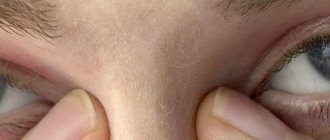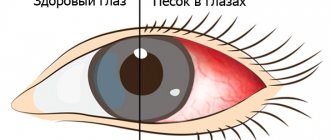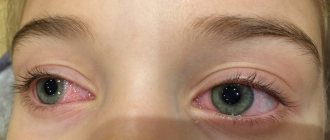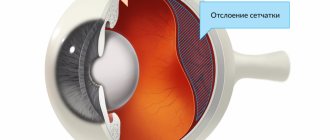What is dry eyes?
The outer surface of the eyeball should always be moistened. In the mucous membrane of the eye, special glands produce tear fluid.
When the eye blinks, tears are distributed evenly over the entire surface of the eye, forming a protective film. When tear production decreases or its composition changes, dry eyes develop.
Dry eyes are a subjective sensation that occurs due to a lack of eye hydration. Dry eyes are most common in women.
It's not just adults who suffer! Dry eye syndrome in children: symptoms and treatment
Dry eye syndrome in children ( xerophthalmia or dry eye syndrome ) is an eye pathology that develops against the background of insufficient hydration of the conjunctiva caused by a decrease in the volume of tear fluid.
The latter normally reaches 10 microns in thickness . The liquid is needed to protect the eyes from dust, other contaminants, and aggressive environmental influences. Previously, xerophthalmia was called an adult pathology. Now the diagnosis is often given to children.
ontakte
Odnoklassniki
Why do children's eyes suffer from painful conditions? Why is the surface of the organs of vision poorly moisturized?
The fluid that fills the tear film contains salts and proteins. When you cry, fluid is released and forms tears .
The layer is nourished by special glands that are located on both sides of the visual organs, on the outside. The fluid that the glands supply to the tear layer is enough to moisten the eye when blinking.
But this is in the case of continuous and proper function of the glands. When it is damaged, the surface of the conjunctiva is poorly moisturized and a condition known as dryness occurs. When the eye develops, it reacts painfully to wind, light and smoke due to the fact that dryness provokes irritation.
Causes of the disease
Doctors know a number of reasons why a malfunction occurs, leading to insufficient hydration. Their list:
- fungal, bacterial and viral damage to the eye membranes;
- congenital pathologies;
- allergy;
- a structural feature of the eyelids that does not allow complete closure, resulting from injury or congenital;
- excessive width of the lacrimal canaliculi;
- thyroid diseases;
- dry climate conditions;
- burn of the corneal layer caused by laser vision correction.
Symptoms of dry eye syndrome in a child
Whatever the reason, the symptoms of the disease at the initial stage in children of different ages are the same. The difference is in the sensations that children experience.
For example, teenagers endure the discomfort that the disease gives them, and kids are capricious, rubbing their eyes, thereby complicating the situation and intensifying the signs that are characteristic of the course of the pathology.
Doctors include the latter:
- redness of the eyelids;
- itching, pain, feeling of sand in the eyes;
- formation of a network of blood vessels on proteins;
- runny nose;
- flow of tears;
- photophobia;
- poor sleep and appetite;
- discharge that dries and forms a crust on the eyelashes.
Causes of dry eyes
There are many reasons for the appearance of this symptom:
Ocular causes
- Refractive surgery (LASIK, keratoplasty, etc.) After surgery on the cornea, dry eyes may develop.
- Eye drops. Many medications that are instilled over a long period can cause the appearance of this symptom - dry eyes. These include steroid eye drops and drugs that reduce eye pressure.
- Chronic blepharitis. The cause of a significant percentage of dry eyes is an insufficient amount of oily secretion, which is produced by the meibonium glands of the eyelids.
- Lagophthalmos. Incomplete closure of the eyelids due to aging and sagging eyelid muscles or as a complication after eyelid surgery (blepharoplasty)
- Long-term wearing of contact lenses
- Pregnancy
- Vitamin A deficiency
General diseases
Diseases such as rheumatoid arthritis, diabetes mellitus, and herpes zoster lead to decreased tear production and the development of dry eye.
Hormonal changes
Hormonal changes associated with menopause are the main cause of dry eye development in women.
Constant use of medications
A wide range of medications can cause dry eyes (see Diuretics, beta blockers, sleeping pills, antidepressants, antihistamines).
Physical factors
Prolonged exposure to or exposure to harsh environmental conditions can lead to the development of dry eye.
Dry eye: causes, symptoms and treatment of dry eye syndrome (keratoconjunctivitis sicca)
Normally, the tear film breaks down, causing the eye to become dry. This makes a person want to blink, because it is in the process of blinking that the film is restored and can fully perform its functions. But when it evaporates too quickly and cannot fully recover, dry eye syndrome develops.
Causes of the disease
The causes of “dry eye” can be primary, that is, the syndrome develops as an independent disease, or secondary, when the disease occurs against the background of another pathology. The second option happens much more often.
Keratoconjunctivitis sicca can develop for the following reasons:
- Sjögren's syndrome and disease, in which damage and disruption of the functions of various glands of the body occur, including the lacrimal glands. With this disease, not only the production of tears decreases, but their composition also changes. As a result, the consistency of the tear also changes: it becomes viscous and thick, losing most of its bactericidal composition. There are also many reasons why Sjögren’s disease develops: SLE, rheumatoid arthritis, etc.
- The causes of dry eye syndrome in women are often associated with hormonal imbalance or changes in the body.
- Neurological pathologies or abnormalities of the eyelids can lead to incomplete closure of the palpebral fissure, as a result of which the natural process of hydration of the visual organ is significantly disrupted. This leads to dryness and burning.
- The causes of the disease known as dry eye syndrome may also be hidden in the use of certain medications. Antidepressants, oral contraceptives, uncontrolled use of antibacterial or glucocorticosteroid eye drops, nasal vasoconstrictors, and some glaucoma medications can have a negative effect on the eyes.
- Dry eyes often develop due to the use of contact lenses. When they dry out, tear fluid is absorbed, which, in turn, leads to excessive dryness of the eye.
In addition, the following factors may influence the development of the disease:
- unfavorable environmental conditions;
- weather conditions (wind, frost, heat);
- prolonged sitting at the computer, the cause of which dry eye syndrome is also called “office” or “monitor” disease;
- vitamin A deficiency.
There are several other causes of dry eye disease. These include:
- chronic conjunctivitis;
- neurotrophic or neuroparalytic keratitis;
- lagophthalmos;
- bepharoplasty;
- previous operations on the cornea.
Keratoconjunctivitis sicca is a pathology that also develops in children. The reason for this may be:
- allergic reaction to dust, wool, pollen and other allergens in the air;
- eye infections of fungal, bacterial or viral etiology;
- congenital anomalies of the lacrimal glands (in particular, too wide lacrimal canals);
- congenital eye pathologies;
- previous eye injuries.
Having found out the causes of the development of dry eye syndrome in children and adults, the doctor will be able to prescribe effective therapy. Without this, no treatment methods will help get rid of the disease.
At-risk groups
Dry eye syndrome, or dry eye syndrome, most often develops in people who:
- use contact lenses that do not suit them;
- suffer from thyroid diseases;
- Due to work responsibilities, they spend a lot of time at the computer;
- suffer from Parkinson's or Sjögren's disease.
Dry eye is a disease that develops in women:
- during menopause;
- during pregnancy;
- during lactation;
- with abuse of hormonal oral contraceptives.
Dry eye syndrome in children often develops due to excessive time spent at the computer. In addition to this disease, the child may develop other ophthalmological pathologies, so parents need to reconsider their attitude towards the issue of the child watching the monitor.
Frequency of pathology development
Keratoconjunctivitis sicca is a fairly common anomaly. It occurs in 5–6% of all ophthalmic diseases, but its prevalence is high, mainly among adults. In children, although the disease occurs, it is much less common - only 1–3% of cases.
Clinical signs
Symptoms of dry eye depend on the stage of the disease. There are 3 of them:
- light;
- average;
- heavy.
Let's look at the symptoms of dry eye syndrome depending on the form of the disease.
Mild degree
Signs of a disease in the first stage of development manifest themselves through the occurrence of:
- periodic sensation as if something is in the eye;
- dry eyes that occur under the influence of even minor external irritants.
Mild dry eye syndrome is easily curable. But alas, many ignore the symptoms, which is why the disease smoothly flows into the next stage of development.
Average degree
Symptoms of moderate dry eye may occur through:
- burning and itching in the eyes;
- photophobia;
- redness of the whites of the eyes;
- frequent watery eyes caused by the body’s natural need to moisten a dry eye.
Moderate keratoconjunctivitis sicca is not dangerous, but it cannot be ignored. Especially if the disease manifests itself in a child.
Severe form
Symptoms of severe dry eye syndrome are characterized by damage to the conjunctiva and cornea. Their pathological structural changes occur. The patient begins to suffer from frequent relapses of conjunctivitis and blepharitis; he cannot manage moisturizing eye drops.
All symptoms characteristic of moderate severity of the pathology remain, but appear much more clearly. Burning, stinging and itching of the visual organs cause significant discomfort, but this is not the most dangerous.
If the signs of severe dry eye syndrome are ignored for a long time, local immunity decreases. As a result, microscopic erosions or ulcers may appear on the surface of the cornea. Often, a sick person develops filamentous keratitis or a corneal ulcer.
Clinical picture in children
Dry eye syndrome in a child has a pronounced picture, which parents should pay special attention to. The symptoms of the pathology are as follows:
- the appearance of slight redness of the eyelids, which over time occupies a large area of the skin;
- the child complains of a feeling of sand, pain, burning in the eyes;
- the appearance of spider veins on the whites of the eyes;
- the appearance of yellowish discharge that dries in the corners of the eyes;
- problems with blinking, when the baby begins to squint more than usual;
- increased lacrimation;
- photophobia.
Nonspecific symptoms in children can manifest themselves through:
- tearfulness;
- discomfort in the eyes;
- headache;
- nervousness;
- loss of appetite;
- restless sleep.
Another common symptom of dry eye syndrome in children is a runny nose. When the intensity of the lacrimal glands increases, fluid flows into the nasal cavity, which leads to its discharge from the nasal passages.
Features of treatment
How to cure dry eye syndrome, and can it be done? Yes, it is possible to be cured, but only if you contact an ophthalmologist in a timely manner.
The fact is that after some time the acute phase of the pathology will pass, and the symptoms of developed dry eye syndrome will disappear. But the disease itself will remain, which will only worsen the situation.
Treatment of dry eye syndrome requires the mandatory use of eye moisturizers. But they can be used only in the initial stages of the disease. In later stages of development, surgical intervention is performed.
Conservative therapy
How to treat dry eye with medications? First of all, it is necessary to use “artificial tears” preparations. They moisturize the eye, relieve stinging, burning, itching and pain. But, despite their safety, you need to know how to treat dry eye syndrome with their help correctly. Study the instructions carefully, follow the doctor’s recommendations, and the therapy will give results.
If dry keratoconjunctivitis is accompanied by infectious diseases, drops with an antibiotic (for example, Sulfacil) are used. You need to drip them carefully into the corners of your eyes, 2-3 drops in each. After the procedure, you need to lie down for a few minutes for the medicine to take effect.
Treatment of dry eye can also be carried out through the use of topical products containing an antibiotic (for example, tetracycline ointment). But to achieve maximum results from therapy, eye drops are still necessary.
Surgical intervention
How to cure dry eye syndrome if medications do not help? There is only one way out - to resort to surgery. It is necessary if the pathology is at a late stage of development with damage to the conjunctiva and structural changes in the cornea.
How to treat dry eye syndrome with surgery? There are several options.
- Tamponation of the tear ducts. Treatment of dry eye syndrome using this method involves the use of special tampons that are placed in the tear ducts, preventing tear fluid from entering them. Thanks to this, the eye always remains moisturized.
- Eyelid surgery is used when dry keratoconjunctivitis in a person has developed due to incomplete closure of the eyelids.
- Laser coagulation. Treatment of “dry eye” can also be carried out using an instrumental procedure such as laser coagulation of the tear ducts. This modern therapeutic technique is one of the most highly effective, but its significant disadvantage is its high cost.
Is it possible to cure dry eye syndrome completely and avoid relapse? If, after applying therapeutic techniques, you follow all the doctor’s recommendations, this unpleasant disease will no longer remind you of itself.
about dry eye syndrome
Source: https://okulist.pro/bolezni-glaz/sindrom-suhogo-glaza.html
Treatment for dry eyes
Dry eye syndrome is usually a chronic condition. In most cases, treatment results in improvement and relief of the eye condition.
Artificial tears
Artificial tear eye drops are similar in composition to our own tears. They moisten the eyes and help retain moisture.
Artificial tears are available without a prescription.
There are many options on the market, so you can try several to find the one you like best. In case of increased sensitivity of the eye mucosa and frequent instillation, it is recommended to use artificial tears without preservatives.
Temporary method of closing tear ducts
The tear ducts are temporarily closed with special plugs. They block the tear duct and the tear film in the eye becomes more stable, reducing dryness. Tears simply evaporate from the surface of the eye.
Gland massage
For chronic inflammation of the eyelids and insufficient production of oily secretions, massage of the meibonium glands is recommended.
Dry eye syndrome in children
Many ophthalmological diseases cause dryness of the mucous membrane of the eyes. If this condition develops over a long period of time, it is called dry eye syndrome, or xerophthalmia.
The pathology is dangerous due to severe drying of the cornea, on which microtraumas and cracks will form. Pathogenic microflora can penetrate into them, causing an infectious infection. It is recommended to eliminate the disease immediately, which reduces the risk of complications.
We recommend reading: Dry eye syndrome
Causes of dry eye syndrome in children
The condition can develop in children for the following reasons:
- penetration of various pathogenic microorganisms onto the surface structures of the eyeball (bacteria, viruses, fungi);
- congenital condition;
- allergic reaction to seasonal flowering of plants, household factors, animal hair and bird feathers;
- congenital pathology, acquired disease, as a result of which a deformation of the eyelid is formed, leading to incomplete closure of the eyes, tear fluid is not retained on the mucous membrane, causing dryness;
- pathology of the lacrimal glands, sac, canal;
- endocrine disorders (pathology of thyroid function);
- increased dryness of the environment in a constantly hot climate;
- burns, mechanical damage, inflammation of the cornea.
The doctor needs to identify the root cause, since for each of them there is a separate treatment method.
Symptoms
Regardless of what cause led to the pathology, dry eyes manifest themselves in the same way:
- redness of the conjunctiva, eyelids;
- discomfort in the eyes - itching, burning, pain, pain, sensation of a foreign body under the eyelids;
- clear identification of capillaries on the surface structure of the eyes, visible to the naked eye;
- increased sensitivity to bright light;
- if a bacterial infection is added to the pathology, or the normal microflora of the eyes multiplies excessively, purulent discharge is formed, which dries out in the morning and sticks the eyelashes together.
Based on these signs, a doctor can suggest a disease, but only diagnostic tests can confirm it.
Risk group
The following groups of children are most susceptible to this disease:
- often suffering from bacterial, viral, fungal diseases of the eyes or neighboring areas, for example, sinuses, tonsils;
- having a history of complete blockage of the lacrimal canal;
- having hereditary or congenital diseases in which the eyelids do not close completely;
- children whose parents or other close relatives suffer from congenital xerophthalmia or diseases leading to it.
These categories of patients need to periodically visit an ophthalmologist to prevent the disease and its complications.
Diagnostics
The patient's condition can be determined using several diagnostic tests:
- Interview with the patient or his parents. The most common complaints are constant eye dryness, severe irritation and redness.
- Slit lamp examination. The doctor discovers damage to the cornea, which is not visible without special instruments.
- Biomicroscopy. This is a lifetime study. An ophthalmological microscope is brought to the patient's eye, with which doctors evaluate the quality of the eyeball cells.
- Assessment of visual acuity. Diagnostic tables are used, on which pictures or letters are drawn. The more lines a child sees, the better his vision function.
- Fundus examination. This test is necessary to prevent complications that occur at an early stage. Atropine or similar agents are first instilled into the child's eyes. The doctor evaluates the condition of all elements inside the eyes.
If a child has a concomitant pathology, other research methods may be used. For example, in case of strabismus, the ophthalmic perimeter and determination of the angle of deviation of the eyeball are used. For a bacterial infection, a culture of the discharge from the eyes is done.
Treatment
For children, it is possible to use only medicinal drops that moisturize the mucous membrane of the eyes. The advantage of such funds is the possibility of frequent use, while no addiction or complications arise.
Most often, ophthalmologists prescribe Defislez, Slezin. They are highly effective at low cost.
If the child has damage to the superficial structures of the eye, the doctor will prescribe additional medications:
- non-steroidal anti-inflammatory drops;
- medicines that accelerate tissue healing (Solcoseryl);
- multivitamins to accelerate metabolism in the organs of vision (Blueberry Forte).
In addition to treating dry eye, the doctor may prescribe therapy for the underlying disease using the following means:
- antibacterial;
- antiviral;
- antihistamines;
- antifungal.
All medications must be used in strict dosage. Self-therapy is not recommended.
Complications
If the eyes are excessively dry with the formation of xerophthalmia, the following complications may occur if left untreated:
- corneal hemorrhage;
- microtraumas and cracks on the surface of the cornea;
- constant photophobia;
- sunken eyes;
- periodic spasms of the eyelids;
- decreased visual acuity.
To eliminate complications, you must immediately consult a doctor and promptly carry out treatment.
Forecast
With timely treatment, the prognosis of the disease is positive. The child's vision function will be completely restored. With some complications, it is impossible to completely restore normal eye hydration with the help of your own body. Then the child will need lifelong replacement therapy with moisturizing drops.
If the parents did not treat the child, irreparable complications will arise. He may completely lose vision in one or both eyes.
Prevention
To eliminate the possibility of xerophthalmia, it is recommended to adhere to the following rules:
- timely treatment of systemic and ophthalmological diseases;
- timely treatment of the initial stage of dry eyes;
- periodic visits to an ophthalmologist;
- complete restoration of the eyes after mechanical damage to the surface structures;
- therapy of congenital pathologies.
Dry eye syndrome is a dangerous disease that can lead to decreased vision function. This pathology can be easily eliminated with the help of medications. Therefore, when the first symptoms appear, you should immediately consult a doctor.
Was the article helpful?
Source: https://proglazki.ru/bolezni/sindrom-suhogo-glaza-u-detej/
Treatment of dry eyes with folk remedies
Warm compresses. An alternative to massage is warm compresses on the eyelids to soften the secretion of the glands and facilitate its removal. Warm compresses are made from chamomile infusion.
Honey drops. In some cases, putting honey drops into the eye helps. Honey is diluted with boiled honey in certain proportions.
This method has contraindications for use. Therefore, be sure to consult your ophthalmologist before using.
Preventing dry eyes
If you have initial symptoms of dry eyes, you should do the following for prevention:
Blink more often
When using a computer, smartphone or other digital device, we tend to blink less often. As a result, dry eyes may develop. Make a conscious effort to blink frequently when using these devices. In addition, you can periodically close your eyelids completely and close your eyes to renew the tear film.
Take frequent breaks while using the computer
Make it a habit to look away from your screen every 20 minutes and look at something that is at least within your reach for at least 20 seconds.
Following this simple rule will not only prevent the development of dry eyes but also preserve your vision.











